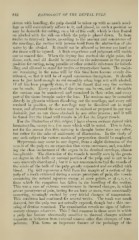Page 832 - My FlipBook
P. 832
842 PATHOLOGY OF THE DENTAL PULP.
sistent with handlings the pulp sliould be taken up with as much niiici-
hige as will conveniently adhere to it, and placed, in such a position as
may be desirable for cutting, on a bit of fine cork, which is then floated
on alcohol with the side on which the pulp is placed down. In from
twelve to thirty-six hours, according to the amount and consistence of
the mucilage, the surface will become hard from the abstraction of the
water by the alcohol. It should not be allowed to become too hard or
the tissue will be injured. A little experience and judgment will enable
one to control this. When the drying has reached the right point, the
tissue, cork, and all should be invested in the microtome in the proper
position for cutting, using paraffin or other suitable substance for imbed-
ding, and allowed to stand for twelve or twenty-four hours. The moist-
ure remaining in the mass will by this time have become evenly dis-
tributed, so that it will be of equal consistence throughout. It should
now be just hard enough to cut smoothly when kept wet with alcohol.
If all has been properly done, it Mill be found that very fine sections
can be made. Every particle of the tissue can be cut, and if desirable
the sections can be munbcred and examined in their order, and every
part of the tissue brought under the lens. The sections may be mounted
directly in glycerin without dissolving out the mucilage, and every cell
retained in position, or the mucilage may be dissolved out in tepid
water, and afterward the section may be stained or prepared in any way
desirable, just as can those obtained by any other process ; and it will
be found that the blood will remain in all but the largest vessels.
For the illustration of this subject I have chosen sections stained with
hsematoxylin, except in a few cases which will be noted. - This is done,
not for the reason that this staining is thought better than any other,
but rather for the sake of uniformity of illustration. In the study of
any such subject the various modes of preparation should be employed.
Hypersemia may occur in any degree, from a slight distension of the
vessels of the pulp to an expansion that seems enormous, and, consider-
ing the close encasement of the organ in its dentinal envelope, almost
inexplicable. The distension of the vessels is usually seen iij the great-
est degree in the bulb or coronal portion of the pulp, and is apt to be
very unevenly distributed ; but it is not uncommon to find the vessels of
the whole of the bulb of the pulp greatly expanded and overfilled with
blood. Fig. 443 represents a field from the margin of a section of the
pulj) of a tooth extracted during a sev^ere jjaroxysm of pain, the vessels
containing the natural injection except at some points, as at c, c, e, c,
from which the coagulum has fallen in the handling of the section.
This was a case of extreme sensitiveness to thermal changes, in which
severe paroxysms of pain, lasting for an hour or more, were occasionally
occurring, seemingly excited by very trivial changes of temperature.
This condition had continued for several weeks. The tooth was much
decayed, but the l>ulp was not actually exposed, though but a thin cov-
ering of dentine remained. The examination reveals no signs of inflam-
matory changes whatever. This I find common in those cases in which
a pulp has become abnormally sensitive to thermal changes without
exposure or irritation from external sources other than changes of tem-
perature. This forms an important feature of the pathology of the


